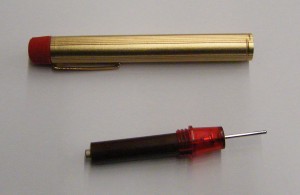It can be part of a registrar’s work to find out, what an artifact actually is. It might sound strange but there are many objects in this world that might leave you clueless if you never saw them before. This pen is such an object that began as a “What-is-it”, an unidentified object with unknown use. This is a story about how the object got its name and meaning back.
As a registrar you start with looking at the object to find out about its use and if possible about its context. In this case it was among a donation of a radio ham which suggested that it might be something you use for fixing a ham radio equipment or something. Our closest guess was that it was a circuit tester, but somehow this explanation didn’t satisfy us.It was too far away from the circuit testers we knew and already had in our collection. If in doubt, it’s best to ask. So we send a request over the mailinglist of the RCAAM with the following picture and description:
while working on a donation from a radio ham we came across this really weird item.
It is about 6,7 inches long, the diameter is 0,44 inches. It has a clip on the side like to attach it to one’s shirt pocket. You can turn the red plastic knob at the rear end in a 90 degrees angle until it gives a clicking sound. You can twist off the red thing with the metal bolt at front end, so you can insert two AA-batteries in the shaft. Inside of the red transparent plastics thing at the front you can see that the metal bolt is soldered to something inside the pen and also soldered with a little lamp (not betting on anything, but it seems to be a light bulb, not LED) inside.
As we all know, networking works. No one came up with a better guess than a electrical continuity tester, but one colleague pointed us to an electronics shop in Berkeley/California/USA saying: “These folks would be able to answer just about anything regarding electronic devices”.
The answer came within hours, straight and clear:
Hi
I think it’s a Buzz-it.
It’s a signal injector
Bob Lasher
http://www.antiqueradios.com/forums/viewtopic.php?t=812
Now we knew it was a kind of small oscillator to analyze what part of a radio didn’t work. We even had pictures of a similar device including a short manual.
I think it’s a great example that working with collections is never boring. It includes a great deal of detective’s work and sometimes even international collaboration.
Angela


I believe it was marketed under the brand name of Buzz-it”. A speedy way to generate a signal for a fast trouble shoot. Wish they still made them..
I would likt to know were i can get one of these
Wow! I just felt the need for a signal injector, and I googled to see if someone still sells them. I got this hit as one of the few. and this signal injector is identical to the one I had as a kid. It takes a 1.5v battery (size AA) just as a flashlight where the + touches the metal tap on the black part (wich is in fact the top of an old fashioned transistor), and there should be a spiral spring at the bottom of the cover. When you twist it to a click you turn it on(off) and the light should show on state (if the bulb works).
This pen will inject some buzz noise into any circuit and it is (or rather was) used to test/debug electronic circuits.
I am not 100% sure about this, but it might have been bought from Maplin electronics back in the late 70’s or 80’s.
________
Español:
¡Caray! Tenía la necesidad de un inyector de señal, y busqué en Google para saber si alguien aún los vendía. Tengo este logro como uno de los pocos, y este inyector de señal es idéntico al que tenía cuando era chica. Éste acepta baterías de 1.5 voltios (talla AA) tal como una linterna, donde el positivo (+) toca el contacto de metal en la parte de color negro (como suele estar, de hecho, en la parte superior de cualquier viejo transistor pasado de moda), y debe haber un resorte en espiral en la parte inferior de la cubierta. Cuando lo mueves para hacer el clic de encendido (desde off), la luz debería mostrarse en estado encendido (on, si el bombillito funciona).
Este bolígrafo inyecta un suave zumbido en cualquier circuito, y es (o más bien, era) usado para probar/depurar circuitos electrónicos.
No estoy 100% segura sobre esto, pero pudo haber sido adquirido de Maplin electronics allá por los tardíos 70s u 80s.
Hi Morton,
yeah, it’s exactly that way you describe! So happy to hear of someone who knows this exact model. Makes it even more valuable for our collection.
Cheers!
Angela
________
Español:
Hola Morton:
síp, ¡es exactamente del modo en que lo describes! Me hace muy feliz escuchar de alguien quien conoce exactamente ese modelo. Eso lo hace incluso más valioso para nuestra colección.
¡Salud!
Fernando